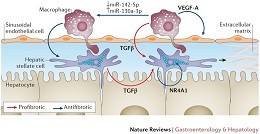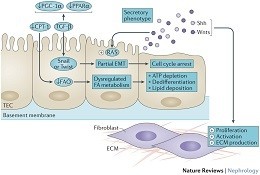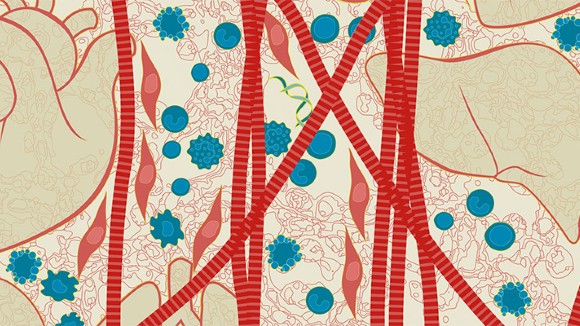 Liver fibrosis in 2015: Crucial steps towards and effective treatment
Liver fibrosis in 2015: Crucial steps towards and effective treatment
Klaas Poelstra
Nature Reviews Gastroenterology & Hepatology: Year-in-Review commentary
In 2015, new tools were developed to modulate fibroblast and macrophage activity to halt liver fibrogenesis and stimulate resolution. Essential factors for resolution were identified and clinical trials yielded potential new antifibrotic drugs. Although innovations were made this year, clinical trials are still hampered by the lack of methods to monitor disease progression.
 Renal fibrosis in 2015: Understanding the mechanisms of kidney fibrosis
Renal fibrosis in 2015: Understanding the mechanisms of kidney fibrosis
Dong Zhou & Youhua Liu
Nature Reviews Nephrology: Year-in-Review commentary
The year 2015 has seen great progress in the renal fibrosis field, as key studies began to build a consensus on the importance of epithelial-to-mesenchymal transition, cell cycle arrest, and defective metabolism in the pathogenesis of kidney fibrosis. New findings also point to a role of developmental signalling in renal fibrogenesis.
The NASH drug dash
Kelly Rae Chi
Nature Reviews Drug Discovery: News and Analysis
Intercept Pharmaceuticals has announced plans for the first ever pivotal trial in non-alcoholic steatohepatitis (NASH), setting a high bar for a growing pipeline of drugs against the liver disease.
Lung mapping seeks to crack microbial code in cystic fibrosis
Shraddha Chakradhar
Nature Medicine: News
In diseases such as cystic fibrosis, the movement of certain microbes to certain lung regions can determine the extent of disease and be responsible for flare-ups. Understanding the location and types of bacteria in the lungs could lead to drastically more-effective treatments for potentially fatal lung infections in people with cystic fibrosis.
The cystic fibrosis drug market
Basharut A. Syed & Bashar Hamad
Nature Reviews Drug Discovery: News and Analysis
Cystic fibrosis (CF), also known as mucoviscidosis, is a lethal common autosomal-recessive disorder. The highest incidence of CF is among Caucasians of northern European descent, occurring in approximately 1 in 2,500 live births.Worldwide, over 75,000 people are affected by the condition.
False dawn for cystic fibrosis disease modifiers?
David Holmes
Nature Reviews Drug Discovery: News and Analysis
Recent results have cast doubt over how effective a breakthrough class of cystic fibrosis drugs can be in patients with the most common form of the disease.
Fatty liver disease: The liver labyrinth
Branwen Morgan
Navigating the path that connects fatty liver disease to cancer has proved tricky.

